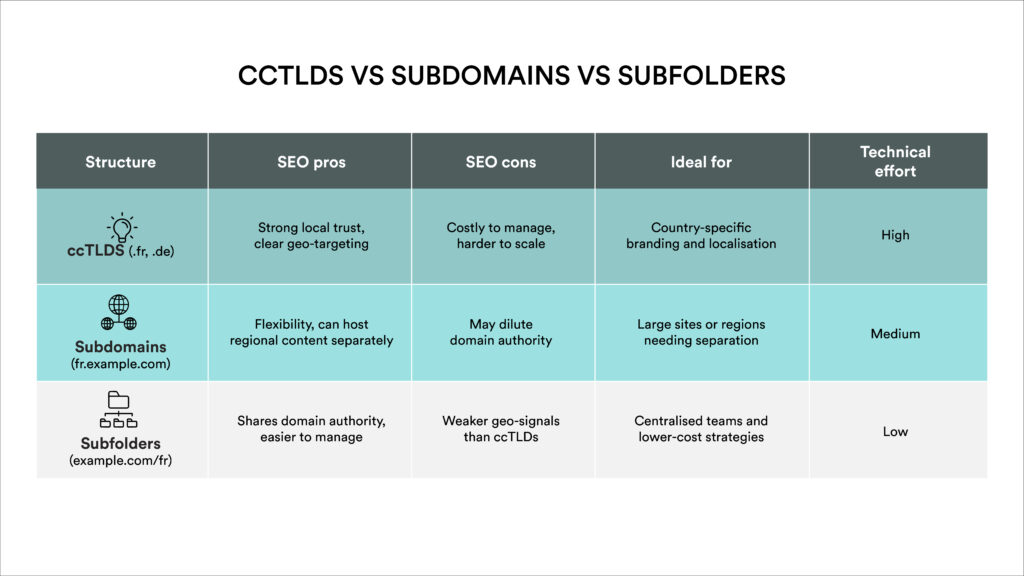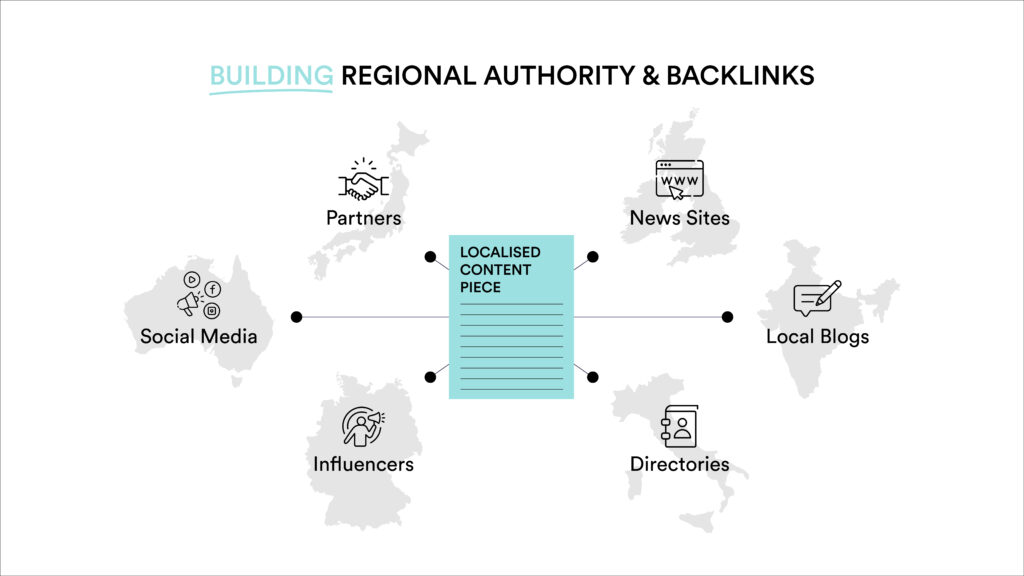
Global SEO strategy: master international SEO today
Summary
A global SEO strategy requires more than translation – it demands deep understanding of local search intent, technical optimisation, and cultural relevance. Success depends on adapting content, structure, and UX for each region, using localised keywords, and building authority through backlinks. With AI-driven search prioritising relevance and quality, businesses must align SEO efforts with regional behaviours to boost visibility, engagement, and conversions worldwide.
A global search engine optimisation (SEO) strategy helps your business rank in multiple countries and languages – but it’s about a lot more than translation. It means understanding local search behaviour, technical requirements and cultural context so your content performs in every market you target.
Amid the rapid development of AI-enhanced search experiences, getting international SEO right is more important than ever. These tools surface more curated results, giving an edge to businesses with technically sound, well-optimised, locally relevant content.
However, many marketers run into the same challenges, such as:
- Traffic arriving from the wrong countries or in the wrong language
- Duplicated content across domains
- Poor conversion rates in key regions
- Unclear site structure
This guide explores how to tackle these problems – from decoding cross-border search intent to choosing the right URL structure – and shows how you can build a scalable, successful global SEO strategy tailored for today’s digital landscape.
Crafting a winning global SEO strategy: key pillars for international success
Understand search intent across borders
Search intent varies widely between regions, even when the keywords look the same. A global SEO strategy needs to go beyond language and consider local behaviours, platforms and expectations.
Start by distinguishing between local and global intent. Someone searching for “bank account” in the UK is likely looking for national providers, while the same query in the UAE might lean toward expat services. Similarly, searches for “football” in the US refer to a different sport entirely than in Europe.
Search engines also differ. Google may dominate globally, but Baidu is the leading search engine in China, and Yandex is more widely used in Russia. Optimising content for the right platform is just as important as choosing the right keywords.
Understanding these regional differences helps avoid mismatches that lead to irrelevant traffic or poor engagement. Conducting intent research – and looking for opportunities to learn from local users or native speakers – gives you the insight needed to tailor your SEO content accordingly.

The same keyword can signal different user goals depending on geography, language and culture. That’s why understanding search intent is a vital first step in any global SEO strategy.
Comprehensive market and keyword research
Effective global SEO starts with solid research. Before you optimise content or restructure your website, you need to understand how people in your target markets are searching and what topics matter most to them.
Platforms like Google Analytics 4 (GA4) and Google Search Console (GSC) can show where your current traffic is coming from, what keywords are driving visits in each region and where potential gaps exist.
It’s important to go beyond surface-level translation. Keywords that work in one country may not resonate in another, even if the language is the same. This is where local insight becomes essential – either through working with native speakers or using region-specific keyword tools.
Useful tools for international market and keyword research:
- GA4 and GSC – for country-level traffic and engagement insights
- Semrush Market Explorer – to assess demand in new regions
- Semrush Keyword Gap – to compare keyword performance with local competitors
- Semrush Keyword Magic Tool – to generate ideas tailored to specific countries and search intent
- Ahrefs or SE Ranking – for regional keyword volume and competition
- AnswerThePublic – to discover localised question-based searches
Combining data with local knowledge helps ensure your international SEO strategy is informed, relevant and conversion-ready.
Strategic URL and site structure
Choosing the right URL structure is a core decision in any global SEO strategy. It affects how search engines understand your site, how users engage with your content and how easily you can scale operations across regions.
There are three common structures to consider:
- Country code top-level domains (ccTLDs)
- Subdomains
- Subfolders
Each has distinct pros and cons depending on your goals, resources and the complexity of your website.

Your decision should reflect your wider content marketing strategy, including the needs of your audience, regional priorities and long-term growth plans. Whichever structure you choose, it’s important to ensure consistency in implementation and support it with clear technical signals like hreflang tags and sitemaps.
Technical SEO essentials
Getting the technical foundations right is crucial for any global SEO strategy. Search engines need clear signals to understand which version of your content to show, where and to whom.
Here are some essential technical components to address:
- Hreflang tags: These HTML attributes tell search engines which language and regional version of a page to serve. Each page should include self-referencing hreflang tags and reference all relevant versions. Use sitemap-based implementation for large sites and audit tags regularly to prevent mismatches.
- Canonicalisation: Canonical tags help prevent duplicate content issues across similar or translated pages. Make sure the canonical version reflects your SEO priorities for each region and avoid accidentally pointing all versions back to a single default page.
- Crawlability and indexability: Use properly configured XML sitemaps and robots.txt files to ensure your international content is discoverable. Make sure translated pages are mobile-friendly and pass Google’s mobile-first indexing requirements.
- Page speed and hosting: Hosting content closer to the target region can improve load times. Using content delivery networks to reduce latency and optimising images, especially for regions with slower average internet speeds, can help optimise the user experience.
As well as aiding global visibility, solid technical SEO helps to unlock the full benefits of content marketing by ensuring content reaches the right users in the right context.
Content localisation and UX adaptation
A truly effective global SEO strategy goes far beyond simply translating content. To connect with international audiences, you need to localise – not just in language, but in tone, structure, visuals and user experience.
You could start by adapting written content for local context. That means using the right phrases, cultural references and idioms for each region. Even within the same language, nuances matter: a phrase that resonates in the UK might fall flat in Australia or Canada. If you can, it’s beneficial to involve native speakers in content creation or review.
Visuals and formats also need to be localised. Think about image choices, colour meanings and visual metaphors that may carry different connotations across cultures.
Practical UX considerations can also affect trust and conversion rates. That might include:
- Date formats
- Currencies
- Units of measurement
- Local legal requirements
- Forms and address fields (e.g. postcode vs ZIP code, phone number formats)
For businesses building a global content marketing funnel, localising content at every stage (awareness, consideration, decision) ensures prospects stay engaged wherever they are in the buyer journey.
This approach also applies to layouts and design. For instance, text expansion during translation may affect mobile formatting. Consider regional differences in mobile usage, internet speeds and device preferences.
Ultimately, content localisation isn’t a box-ticking exercise – it’s a key part of building credibility and performance in each market you serve.
Building regional authority and backlinks
Establishing trust in new markets also depends on building authority through relevant, local backlinks. For an international SEO strategy to succeed, your domain needs to be seen as credible within each region you target.
Steps you could take to deliver real value and build engagement in target regions include:
- Releasing country-level case studies or testimonials
- Producing localised data reports and insights
- Creating interactive tools like calculators or budget planners
- Publishing culturally relevant blog posts or how-to guides
As well as being highly engaging, these formats encourage sharing and linking from regional media, blogs and industry sites.
Consider collaborating with local influencers, organisations or publications to expand reach and acquire quality backlinks. This is especially useful in B2B content marketing, where trust and expertise are major conversion drivers.

Regional link building takes time, but it’s a powerful way to support visibility, rankings and long-term growth in competitive markets. As search evolves and AI-powered results become the norm, authority signals will remain a core part of SEO and a defining feature in the future of marketing.
Measuring and scaling international SEO
To build a sustainable global SEO strategy, you need to track what’s working, refine where needed and scale up with confidence. That means setting clear key performance indicators (KPIs) and using the right tools to measure progress across different regions.
One way to start is by segmenting performance by country and language in GA4. Key metrics might include:
- Organic traffic per country or subfolder
- Bounce rate and session duration by region
- Conversion rates and lead quality in each market
- Keyword rankings on a per-region basis (using tools like Semrush or Ahrefs)
It can also be helpful to align SEO goals with regional business objectives, particularly when tracking bottom-of-funnel performance.
Key steps to roll out and scale international SEO:
- Pilot in one or two priority regions
- Review local performance against defined KPIs
- Refine content, UX and technical elements based on insights
- Scale successful models to new markets
- Monitor and adapt continuously as search behaviour evolves
With a data-informed approach, global SEO becomes not just a localisation effort, but a strategic engine for growth.
Start scaling your brand with global SEO
Global SEO isn’t just about translation or technical tweaks – it’s about building a strategic, scalable foundation for international visibility and growth. From understanding regional search intent to choosing the right site structure and creating culturally relevant content, every element plays a role in attracting and converting the right audience.
By investing in activities such as smart localisation, regional backlink building and consistent performance tracking, you can future-proof your presence in competitive global markets and turn your website into a genuine growth driver.
If you’re ready to explore or enhance your international SEO strategy, Axonn’s content and search experts can help. Whether you’re entering one new market or scaling across several, we’ll work with you to create a tailored plan that connects content, SEO and business results. Talk to us about your next steps.
